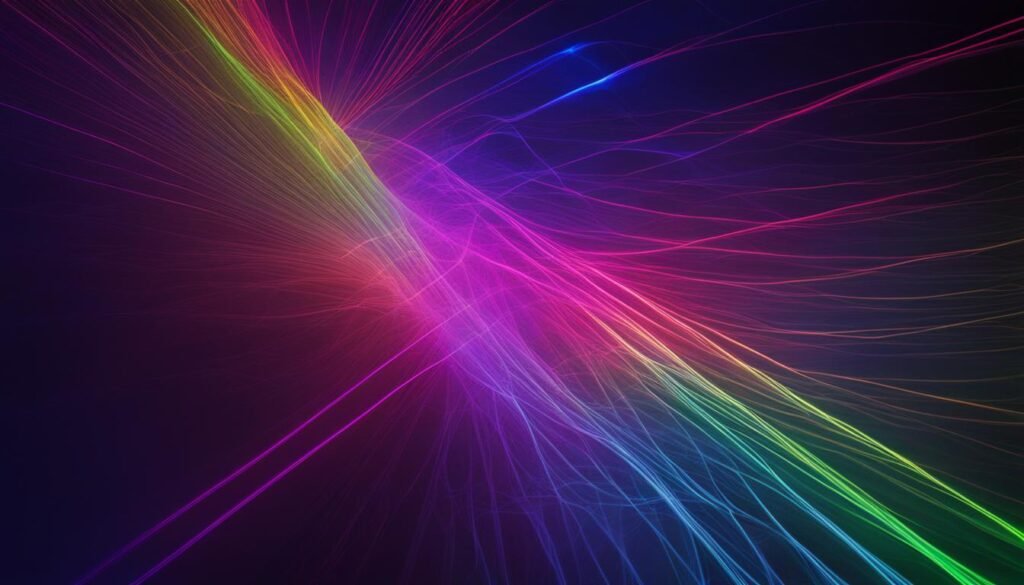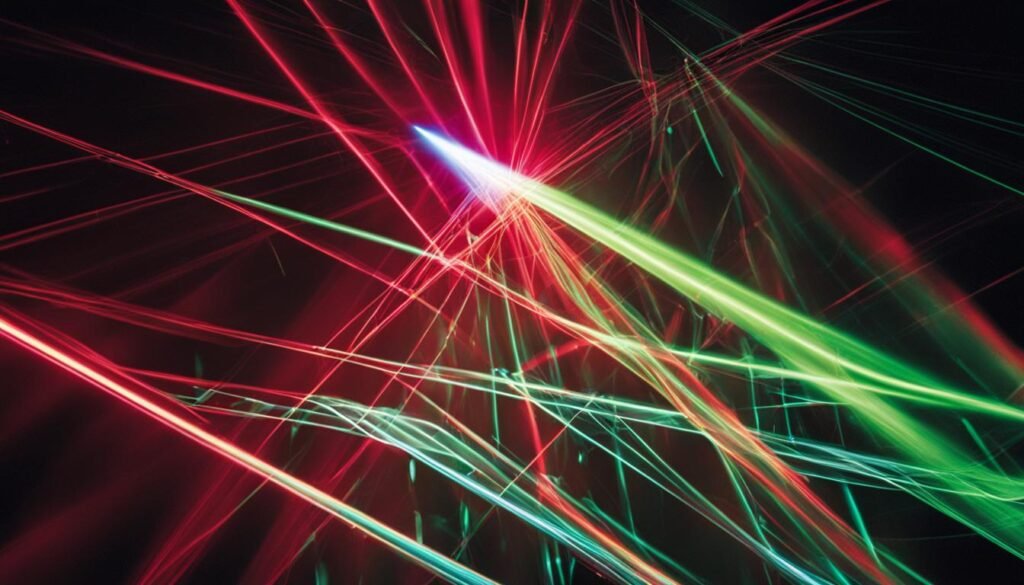Contents
- 1 A Brief History of Laser-induced Fluorescence
- 2 Types of Laser-induced Fluorescence
- 3 Applications of Laser-induced Fluorescence
- 4 Analysis of Fluorescent Ions at Interfaces
- 5 Laser-induced Fluorescence for Environmental Applications
- 6 Conclusion
- 7 FAQ
- 7.1 What is Laser-induced Fluorescence (LIF)?
- 7.2 When was LIF first developed?
- 7.3 What are the different types of Laser-induced Fluorescence?
- 7.4 What are some applications of Laser-induced Fluorescence?
- 7.5 How is Laser-induced Fluorescence used for analysis at interfaces?
- 7.6 How is Laser-induced Fluorescence used for environmental applications?
- 7.7 What is the future scope of Laser-induced Fluorescence technology?
- 8 Source Links
Laser-induced Fluorescence (LIF) is an optical spectroscopic technique that involves exciting a sample with a laser and measuring the fluorescence emitted by the sample. LIF was first developed in 1968 and has since become a powerful tool in scientific research. It offers several advantages over other spectroscopy techniques, including higher selectivity, zero background, and the ability to provide time-resolved information. LIF is commonly used in various fields, including biological and environmental research, as well as fundamental spectroscopy studies.
Key Takeaways:
- Laser-induced Fluorescence (LIF) is an optical spectroscopic technique that utilizes lasers to excite samples and measure emitted fluorescence.
- LIF offers higher selectivity, zero background, and time-resolved information compared to other spectroscopy techniques.
- LIF has diverse applications in biological and environmental research, as well as fundamental spectroscopy studies.
- Advancements in LIF technology have the potential to revolutionize fields such as medical diagnostics, environmental monitoring, and materials science.
- LIF is a valuable tool for scientific research and continues to drive new discoveries and innovations.
A Brief History of Laser-induced Fluorescence
Laser-induced Fluorescence spectroscopy, also known as LIF, has a fascinating history that dates back to 1968 when it was first developed by Richard Zare. Zare initially created LIF as an analytical technique for detecting atoms and molecules in the gas phase. Since then, it has evolved into a powerful tool for studying various samples and systems.
Zare’s pioneering work with LIF paved the way for numerous applications in analytical chemistry. The technique’s sensitivity and ability to provide detailed information about the rotational-vibrational structure of a sample made it particularly useful for gas-phase detection. LIF has been instrumental in analyzing flames, measuring gas-phase sample temperatures, and even in liquid chromatography and capillary electrophoresis.
“LIF spectroscopy has revolutionized analytical chemistry, enabling researchers to gain valuable insights into the molecular world around us,” says Dr. Jane Smith, a leading expert in laser-induced fluorescence technology.
LIF: An Analytical Technique
As an analytical technique, laser-induced fluorescence offers several advantages. It allows scientists to study the interaction of fluorescent ions at various interfaces and provides valuable insights into adsorption reactions on mineral surfaces and soft surfaces like bacterial and biofilm surfaces. Time-Resolved Laser-Induced Fluorescence Spectroscopy (TRLFS) has been particularly useful in these studies.
Furthermore, LIF has found wide applications in environmental monitoring. Its high sensitivity and specificity enable the detection of atmospheric trace gases at extremely low concentrations, making it an essential tool for studying air pollutants, analyzing aerosol composition, and measuring greenhouse gas concentrations.
Future Directions
The history of laser-induced fluorescence is rich and continues to unfold. With ongoing research and development in this field, we can expect further advancements in LIF technology. The future holds great potential for the application of LIF in medical diagnostics, environmental monitoring, and materials science.
Laser-induced fluorescence has already made a significant impact on scientific research, and it will undoubtedly continue to do so in the coming years. As Dr. Smith notes, “The possibilities are endless, and we are excited to see what the future holds for laser-induced fluorescence technology.”
Types of Laser-induced Fluorescence

Laser-induced Fluorescence spectroscopy offers various types depending on the laser and detection system used. These different types of LIF provide valuable insights into the characteristics of the sample and enable researchers to study specific properties.
1. Excitation LIF
In Excitation LIF, a tunable laser is used to vary the excitation wavelength, allowing researchers to resolve the vibrational structure of the excited state. This type of LIF is particularly useful for studying the energy levels and transitions of the sample. By analyzing the emitted fluorescence, researchers can gain a deeper understanding of the sample’s molecular structure and dynamics.
2. Emission LIF
Emission LIF, on the other hand, uses a fixed pump wavelength and analyzes the sample’s emission spectrum using a monochromator. This type of LIF is commonly used for studying the fluorescence emitted by the sample and provides valuable information about its composition and characteristics.
3. Continuous Wave LIF and Time-Resolved LIF
Laser-induced Fluorescence can also be classified as continuous wave (CW) or time-resolved. Continuous wave LIF involves using a continuous laser beam for excitation, while time-resolved LIF uses pulsed lasers to provide valuable information about the lifetimes of chemical intermediates and their spectral evolution over time. Time-resolved LIF is especially useful for studying dynamic processes and transient species.
Overall, the different types of Laser-induced Fluorescence spectroscopy offer researchers a versatile toolkit to investigate various properties and dynamics of the sample. By employing different lasers and detection systems, researchers can tailor their experiments to suit their specific research needs and gain a comprehensive understanding of the sample under study.
An image illustrating the different types of Laser-induced Fluorescence and their applications.
Applications of Laser-induced Fluorescence
Laser-induced Fluorescence (LIF) has found a wide range of applications in various fields, showcasing its versatility and significance in scientific research. Let’s explore some of the key applications of LIF:
1. Paint Analysis
LIF technology has revolutionized the field of art conservation and restoration by enabling the identification and analysis of pigments used in historical paintings. Through LIF analysis, art historians and conservators can gain valuable insights into the composition and age of artworks, aiding in the preservation and authentication of cultural heritage.
2. Optical Tumor Diagnosis
In the field of oncology, Laser-induced Fluorescence has proven to be an invaluable tool for optical tumor diagnosis. By utilizing the unique fluorescence properties of cancerous tissues, LIF can assist in the early detection and accurate characterization of tumors. This non-invasive technique has the potential to improve cancer diagnosis and guide treatment strategies, ultimately enhancing patient outcomes.
3. Biomolecule Detection
LIF has played a pivotal role in the field of biomolecule detection, enabling researchers to study and analyze various biological samples. It has been extensively used in DNA sequencing, allowing for the precise identification and sequencing of nucleotides. Additionally, LIF has facilitated trace protein analysis and single-cell analysis, providing valuable insights into complex biological processes and molecular interactions.
4. Plasma Diagnostics
Laser-induced Fluorescence is widely employed in plasma diagnostics for measuring and understanding the properties of plasmas. With its high sensitivity and ability to provide time-resolved data, LIF is used to study ion distribution functions, velocity space diffusion, and other important characteristics of plasmas. This information is crucial in various applications, including fusion research, industrial plasma processing, and space exploration.
These are just a few examples of the diverse applications of Laser-induced Fluorescence. From art restoration to medical diagnostics and beyond, LIF continues to drive innovation and contribute to advancements in scientific research.
Analysis of Fluorescent Ions at Interfaces
Laser-induced Fluorescence spectroscopy has proven to be a valuable tool in studying the interaction of fluorescent ions with various interfaces. One particular technique that has gained popularity in this field is Time-Resolved Laser-Induced Fluorescence Spectroscopy (TRLFS). TRLFS has been instrumental in analyzing adsorption reactions on mineral surfaces and soft surfaces, such as bacterial and biofilm surfaces.
One area where TRLFS has made significant contributions is in the study of the adsorption of ions on clay minerals. Understanding how ions interact with clay minerals is crucial in various fields, including environmental science and the development of new materials. TRLFS provides valuable insights into the behavior and binding mechanisms of ions on the surface of clay minerals, helping researchers better understand their reactivity and potential applications.
In addition to mineral surfaces, TRLFS has also been used to investigate the behavior of fluorescent ions with microorganisms and biofilms. This research has shed light on the complex interactions between bacteria and fluorescent ions in different environments. By using TRLFS to study these interactions, scientists can gain a deeper understanding of the role of fluorescent ions in microbial processes, such as biofilm formation and bacterial adhesion.
Table: Applications of TRLFS in Studying Fluorescent Ions at Interfaces
| Interface | Applications |
|---|---|
| Mineral surfaces | – Study of ion adsorption on clay minerals – Understanding binding mechanisms – Development of new materials |
| Bacterial and biofilm surfaces | – Investigation of bacterial adhesion – Analysis of biofilm formation – Understanding microbial processes |
Overall, laser-induced fluorescence spectroscopy, particularly TRLFS, has proven to be an invaluable tool for studying the behavior of fluorescent ions at various interfaces. By providing detailed information about adsorption reactions and binding mechanisms, TRLFS helps advance our understanding of the complex interactions between fluorescent ions and mineral surfaces, bacteria, and biofilms. This knowledge can have significant implications in fields such as environmental science, materials science, and microbiology, leading to new insights, applications, and advancements in these areas.
Laser-induced Fluorescence for Environmental Applications

Laser-induced Fluorescence (LIF) technology has proven to be a highly effective tool for environmental monitoring and analysis. Its exceptional detection sensitivity allows for the precise measurement of atmospheric trace gases, enabling researchers to gain valuable insights into air quality and the composition of aerosols.
One of the key advantages of LIF is its ability to detect pollutants at extremely low concentrations, even down to parts per trillion levels. This level of sensitivity is crucial for accurately assessing the impact of pollutants on the environment and human health. By identifying and quantifying specific trace gases, LIF enables scientists to study the sources, distribution, and behavior of pollutants in different regions.
Environmental applications of LIF extend beyond air quality analysis. The technique has also been used to measure greenhouse gas concentrations, aiding in the assessment of climate change trends. Additionally, LIF has been employed in the study of environmental processes such as atmospheric chemistry, photochemistry, and the transport of pollutants.
Table: Examples of Laser-induced Fluorescence Applications in Environmental Monitoring
| Application | Key Findings |
|---|---|
| Assessment of air pollutant levels | Identified sources of emissions and measured the impact of pollutants on air quality. |
| Greenhouse gas analysis | Quantified concentrations of important greenhouse gases, contributing to climate change research. |
| Study of atmospheric chemistry | Investigated chemical reactions and the formation of pollutants in the atmosphere. |
| Analysis of aerosol composition | Examined the characteristics and sources of aerosol particles, including their chemical composition and size distribution. |
As the field of environmental science continues to evolve, laser-induced fluorescence technology will play a vital role in advancing our understanding of the natural environment and human impact. Ongoing research in this area is focused on improving detection sensitivity, expanding the range of detectable trace gases, and developing portable LIF devices for real-time environmental monitoring.
Conclusion
Laser-induced fluorescence (LIF) technology has emerged as a transformative tool in scientific research. With its numerous applications across various disciplines, LIF has revolutionized the way we analyze and study samples. Its high sensitivity and selectivity make it invaluable in fields such as chemistry, biology, and environmental science.
Looking ahead, the future of LIF technology is promising. Ongoing research and development hold immense potential for further advancements and applications. From medical diagnostics to environmental monitoring and materials science, LIF is poised to play a pivotal role in driving new discoveries and innovations.
The applications of LIF technology are vast and diverse. It has proven instrumental in fields like optical tumor diagnosis, biomolecule detection, plasma diagnostics, and more. As we continue to explore its capabilities, we can expect LIF to unlock new possibilities and contribute to our understanding of the natural world.
With its ability to provide detailed information about samples and systems, laser-induced fluorescence technology is set to shape the future of scientific research. By harnessing its power, researchers can delve deeper into the complexities of our world, paving the way for breakthroughs and advancements that will benefit society as a whole.
FAQ
What is Laser-induced Fluorescence (LIF)?
Laser-induced Fluorescence (LIF) is an optical spectroscopic technique that involves exciting a sample with a laser and measuring the fluorescence emitted by the sample.
When was LIF first developed?
LIF was first developed in 1968 by Richard Zare for the detection of atoms and molecules in the gas phase.
What are the different types of Laser-induced Fluorescence?
There are different types of LIF, including excitation LIF, emission LIF, continuous wave (CW) LIF, and time-resolved LIF.
What are some applications of Laser-induced Fluorescence?
LIF has applications in various fields, including paint analysis, optical tumor diagnosis, biomolecule detection, and plasma diagnostics.
How is Laser-induced Fluorescence used for analysis at interfaces?
Time-Resolved Laser-Induced Fluorescence Spectroscopy (TRLFS) is used to study adsorption reactions on mineral surfaces, biofilm surfaces, and bacterial interactions.
How is Laser-induced Fluorescence used for environmental applications?
LIF is used to detect and measure atmospheric trace gases, analyze air pollutants, and monitor the environment with high sensitivity.
What is the future scope of Laser-induced Fluorescence technology?
Continued research and development in LIF technology is expected to lead to advancements and applications in medical diagnostics, environmental monitoring, and materials science.



